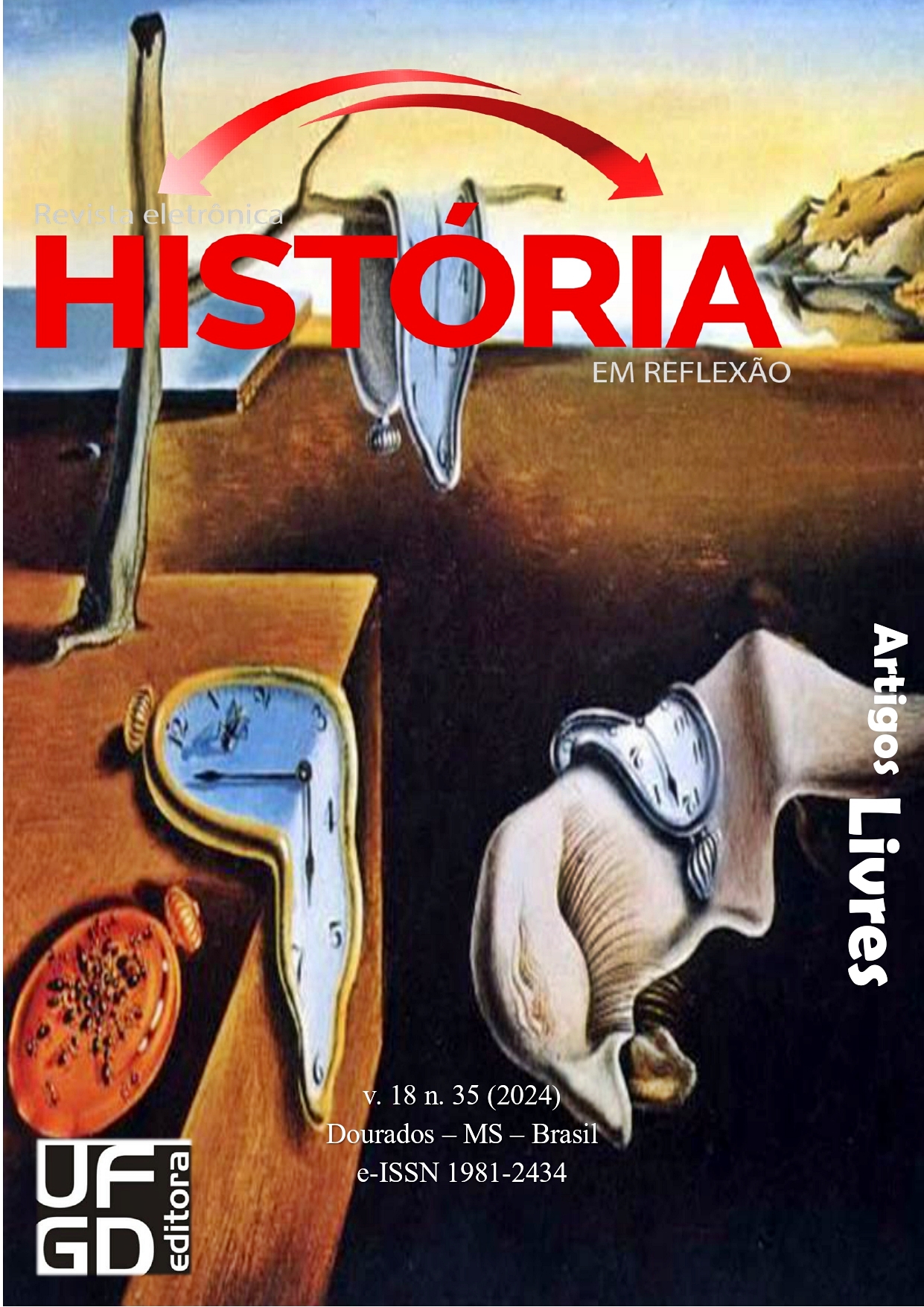Uma análise histórica anarquista das inscrições corporais na sociedade ocidental moderna
DOI:
https://doi.org/10.30612/rehr.v18i35.16476Palavras-chave:
Anarquismo, Inscrições corporais, Estado, Autodeterminação, AutomutilaçãoResumo
Neste artigo, temos como objetivo analisar os processos de estigmatização e patologização aos quais determinados grupos de inscrições corporais foram submetidos ao longo da história da sociedade ocidental moderna. Compreende-se como inscrições corporais todas e quaisquer modificações realizadas sobre a superfície corporal. Enquanto algumas inscrições são exaltadas e enaltecidas, outras são estigmatizadas e alvo de discriminação social. Temos como lente teórica a filosofia anarquista, no intuito de reivindicar a autodeterminação e a autonomia de sujeitos cujas inscrições são marginalizadas, desde aquelas consideradas automutilações até as modificações corporais extremas. Temos como método a revisão bibliográfica. Concluímos, após revisão teórica, que a qualificação de certas inscrições corporais enquanto aceitas e positivas em detrimento da desqualificação de outras, que são tidas como negativas e bizarras, não são processos naturais, mas sim provenientes da densa estruturação de discursos religiosos, psiquiátricos e políticos. A origem da legitimação de certas inscrições é a mesma da deslegitimação e consequente estigmatização, isto é, a autoridade, que provém do Estado, da Igreja e do Hospital, como procuramos argumentar.
Downloads
Referências
ANGEL, T. Pensando sobre as fronteiras entre modificação corporal e ‘mutilação’. FRRRKguys. Beautification, body art & body modification culture, 2014.
BAKUNIN, Mikhail. Conceito de Liberdade. Porto: Edições RÉS limitada, 1975.
BAKUNIN, Mikhail. Deus e o Estado. Portal Domínio Público: Biblioteca digital desenvolvida em software livre, 2001. Disponível em: http://www.dominiopublico.gov.br/pesquisa/DetalheObraForm.do?select_action=&co_obra=2250. Acesso em: 20 de fevereiro de 2021.
BAKUNIN, Mikhail. Deus e o Estado. Trad. Plínio Augusto Coelho. São Paulo: Editora Hedra, 2015.
BELL, Timothy M. A Brief History of Bloodletting. The Journal of Lancaster General Hospital, v. 11, n. 4, 2016.
BRÄUNLEIN, Peter J. “Flagellation.” Religions of the World, Second Edition: A Comprehensive Encyclopedia of Beliefs and Practices. Ed. Martin Baumann, J. Gordon Melton. Santa Barbara, CA: ABC-CLIO, 2010, p. 1120-1122.
CHANEY, Sarah. Psyche on the Skin: a history of self-harm. London: Reaktion Books LTD, 2017.
DE MORAES, Wallace. Reflexões sobre o significado de fascismo: Pra quem sabe ler, um pingo é letra. Le Monde Diplomatique Brasil, 2018. Disponível em: <https://diplomatique.org.br/pra-quem-sabe-ler-um-pingo-e-letra/>. Acesso em: 17 de agosto de 2021.
DE MORAES, Wallace de. Crítica à Estadolatria: contribuições da filosofia anarquista à perspectiva antirracista e decolonial. Revista Teoliterária, São Paulo, v. 10, n. 21, p. 54- 78, 2020.
FAVAZZA, A. R. Introduction. In: STRONG, Marilee. A Bright Red Scream: Selfmutilation and the Language of Pain. United States of America: Penguin Books, 1998.
FAVAZZA, Armando R. Bodies under Siege: self-mutilation, nonsuicidal selfinjury, and body modification in culture and psychiatry. 3ª ed. United Stated of America: The Johns Hopkins University Press, 2011.
FOUCAULT, Michel. História da Loucura na Idade Clássica. São Paulo: Editora Perspectivas, 1978.
GOLDMAN, Emma. O indivíduo, a sociedade e o Estado, e outros ensaios. Trad. Plínio Augusto Coêlho. São Paulo: Editora Hedra, 2007.
KROPOTKIN, Piotr Alekseievch. O princípio anarquista e outros ensaios. São Paulo: Hedra, 2007.
LE BRETON, David. Antropología del dolor. Barcelona: Editorial Seix Barral, 1999.
MALATESTA, E. A Anarquia. Trad. Plínio Augusto Coêlho. São Paulo: Nu-Sul/Editora Imaginário; Rio de Janeiro: SOMA, 2001.
MALATESTA, E. Pensamiento y Accion Revolucionarios. Trad. Eduardo Prieto. Org. Vernon Richards. Buenos Aires: Tupac Ediciones, 2007.
MALATESTA, E. Anarquismo e Anarquia. Tradução de Felipe Corrêa. Faísca Publicações Libertárias, 2009. Disponível em: <https://www.anarquista.net/wpcontent/uploads/2013/08/Anarquismo-e-anarquia-Errico-Malatesta.pdf.>. Acesso em: 03 mar. 2020.
MENNINGER, Karl Augustus. (1938). Eros e Tanatos: o homem contra si próprio. São Paulo: IBRASA, 2018.
MINOIS, Georges. History of Suicide: Voluntary Death in Western Culture. Baltimore: The John Hopkins University Press, 1999.
NETTLAU, Max. História da anarquia: das origens ao anarco-comunismo. Frank Mintz (org. e intro.). Plínio Augusto Coêlho (trad.). São Paulo: Hedra, 2008.
PFEIL, Bruno Latini; PFEIL, Cello Latini. Uma perspectiva anarquista sobre o suicídio, a produção da morte e a preservação da vida. Revista Estudos Libertários, Rio de Janeiro, v. 3, n. 8, 2021, p. 121-151.
RECLUS, Elisée. Anarquia pela Educação. (Trad. Plínio Augusto Coêlho). São Paulo: Hedra, 2015.
SKUSE, Alanna. ‘One Stroak of His Razour’: Tales of Self-Gelding in Early Modern England. Social History of Medicine, v. 33, n. 2, 2018, p. 377-393.
SOARES, Thiago Ricardo. A modificação corporal no Brasil - 1980-1990. 1ª ed. Curitiba: Editora CRV, 2015.
STRONG, Marilee. A Bright Red Scream: Self-mutilation and the Language of Pain. United States of America: Penguin Books, 1998.
STRONG, Marilee. Preface. (2009). In: STRONG, Marilee. A Bright Red Scream: Self-mutilation and the Language of Pain. United States of America: Penguin Books, 1998.
Downloads
Publicado
Como Citar
Edição
Seção
Licença
Copyright (c) 2024 Revista Eletrônica História em Reflexão

Este trabalho está licenciado sob uma licença Creative Commons Attribution-NonCommercial-ShareAlike 4.0 International License.
Os autores devem aceitar as normas de publicação ao submeterem a revista, bem como, concordam com os seguintes termos:
(a) O Conselho Editorial se reserva ao direito de efetuar, nos originais, alterações da Língua portuguesa para se manter o padrão culto da língua, respeitando, porém, o estilo dos autores.
(b) Autores mantém os direitos autorais e concedem à revista o direito de primeira publicação, com o trabalho simultaneamente licenciado sob a Atribuição-NãoComercial-CompartilhaIgual 3.0 Brasil (CC BY-NC-SA 3.0 BR) que permite: Compartilhar — copiar e redistribuir o material em qualquer suporte ou formato e Adaptar — remixar, transformar, e criar a partir do material.
A CC BY-NC-SA 3.0 BR considera os termos seguintes:
- Atribuição: Você deve dar o crédito apropriado, prover um link para a licença e indicar se mudanças foram feitas. Você deve fazê-lo em qualquer circunstância razoável, mas de nenhuma maneira que sugira que o licenciante apoia você ou o seu uso.
- NãoComercial: Você não pode usar o material para fins comerciais.
- CompartilhaIgual: Se você remixar, transformar, ou criar a partir do material, tem de distribuir as suas contribuições sob a mesma licença que o original.
- Sem restrições adicionais: Você não pode aplicar termos jurídicos ou medidas de caráter tecnológico que restrinjam legalmente outros de fazerem algo que a licença permita.



